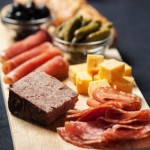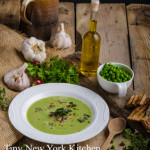Crunchy, juicy, nutrient packed jicama is an unsung hero of the produce aisle. Technically a cousin to green beans, jicama is a root vegetable from Mexico available year-round that is delicious cooked or raw. With a mild, earthy, slightly sweet flavor and an apple like consistency. It’s a great addition to salads, salsas, slaws, and grazing boards. Jicama also works as lighter swap for potatoes in baked and air fried recipes, and it’s delicious sautéed or boiled, too.
If you’ve never tried jicama, don’t be intimidated. Start by choosing one with a smooth, unblemished surface and thin brown skin. The skin should be thin enough to scrape with your thumbnail to reveal the white flesh inside. Avoid thick skinned, bruised, or shriveled jicama, which are signs of aging.
Once you’re ready to prep, start by trimming off the ends of the jicama and slice in half. Then, use a knife to gently peel away the skin.
For Jicama Sticks:
Step 1: Carefully slice off the rounded parts of the jicama, creating a flat surface.
Step 2: Cut each half into 1/4-inch slices.
Step 3: Stack slices and cut evenly into sticks.
Fresh, raw jicama sticks are a great addition to lunchboxes or served on a vegetable platter with your favorite dip. They can also add unexpected, satisfying crunch to cooked dishes, like a noodle salad with jicama and a miso vinaigrette.
Jicama sticks are delicious roasted, too. Their firm texture can withstand the heat, while the edges get golden brown and tender. Toss together with sweet peppers and spices for a simple, satisfying sheet pan side that pairs well with all kinds of meat and fish.
For Diced Jicama:
Step 1: Follow the steps above to create jicama sticks
Step 2: Line up sticks or stack into a pile, then evenly cut into cubes.
Diced jicama is a vitamin and fiber-rich way to add bulk to all kinds of green, grain, and protein-based salads. I love the combination of crunchy jicama with creamy avocado served with grilled chicken.
Moist and mild flavored jicama also plays well with fruit, especially melon. A refreshing combination of watermelon, jicama, and fresh mint falls somewhere between salad and salsa, delicious scooped onto tortilla chips or just spooned straight from the bowl.
Next time you’re at your local grocery store or market pick up jicama and experiment with ways to incorporate it into your recipes.
©Tiny New York Kitchen © 2021 All Rights Reserved
Roasting refers to proteins and vegetables cooked mostly at high temperatures in the oven. Baking uses a lower temperature to cook breads, baked goods, and casseroles.
Roasting makes any vegetable taste better. It brings out their flavor, caramelizes their natural sugars, and adds crunch. If your family doesn’t love certain vegetables like broccoli or Brussels sprouts, roasting is a great way to change their mind. Double what you’re roasting and then turn extra servings into quick meals later in the week. Cooking a little extra with one meal lets you make the most of value-sized packages of proteins and other store sales. With leftover already planned, you won’t need to lean on takeout.
Why we love to roast:
It’s Affordable! Inexpensive ingredients are tastiest when roasted. Root vegetables are browned and crisp, tomatoes and grapes are extra juicy and sweet, and tough cuts of beef are fall-apart tender. You also don’t need any special equipment to roast.
Roasting Is Healthful! Roasted foods need very little fat to cook compared to frying or sautéing. Roasting also intensifies flavors without added salt, sugar, or other ingredients.
It’s Easy! Roasted foods need little prep before they cook. And once the oven door closes, you can walk away. Fewer pans and utensils are needed, making cleanup easier too.
Essential Tools For Roasting:
Rimmed Sheet Pan: The rim keeps vegetables from falling off the sides and catches any juices from meats and fish.
Oven-Save Skillet: Go from stovetop to oven and back. Sear meats before roasting or make a pan sauce with the meat drippings after roasting.
Roasting Pan: Best for large roasts, hams, and turkeys. An inner rack lifts the meat so it can brown and crisp underneath.
Parchment Paper: Line pans to keep foods from burning and sticking, then toss for easy cleanup. If roasting at a higher temp or broiling use foil.
Metal Tongs: Flip and stir foods on a hot pan with ease. Look for tongs with a heat resistant grip.
Silicone Brush: Brush on a sticky glaze or baste foods with sauce. The silicone bristles are easy to clean.
Tips For Sheet Pan Roasting:
Jump Start Browning by preheating your sheet pan before adding vegetables.
Pat foods very dry with paper towels so the outside browns while the inside cooks through.
Cut foods to the same size and thickness so smaller pieces don’t burn.
Space out foods on the sheet pan so they have room to crisp and brown.
Let sheet pans cool before rinsing to keep the metal from warping.
©Tiny New York Kitchen © 2021 All Rights Reserved
A Charcuterie Board makes entertaining super easy. Whether you call it a charcuterie plate or a charcuterie board, it’s easy to make when you begin with quality smoked, cured, and cooked meats. The perfect charcuterie board will contain at least 3 to 5 types of charcuterie representing different styles and textures, an assortment of cheese, plus something acidic, like pickles and olives, and something sweet like fruit chutney to complement the flavors. Nuts, fresh and dried fruits, bread, and crackers also make wonderful accompaniments.
Start with a wooden board, plate, platter, or piece of slate as the base.
Choose at least 3 to 5 charcuterie items that represent various styles and textures: smoked and meaty, dry-cured and firm, cooked and creamy. Allow two ounces per person, and slice your charcuterie into easily manageable, bite-sized pieces.
Spread the pieces out on the board, leaving space between them for accompaniments.
Add mustard, cornichons, olives, or chutney, so the acidity can balance the fat in the charcuterie.
Fresh fruits like grapes, figs, sliced pears, and apples, and any dried fruits like raisins, currants, apricots, cherries, and pears will round out the board, and add color. Use the fruits as palate cleansers between bites of charcuterie.
Place sliced bread, or various types of crackers, around the edges of the board, or tuck them between sections of charcuterie.
Cheese is a welcome addition to a charcuterie board. Choose 2 to 3 types of different textures to complement the spread.
Add truffle butter, which is especially tasty on a slice of bread with dry-cured meats like saucisson sec.
A hearty red wine makes a good accompaniment, such as Côtes-du-Rhône, Gigondas or Madiran.
Types Of Charcuterie To Consider:
Prosciutto: Probably the most recognizable pork offering on the list. Each region of Italy has its own signature recipe and flavor profile, but the most common are from Parma, Tuscany, and San Daniele. Culatello is a boneless cousin of prosciutto with a higher meat-to-fat ration. If you’d like to avoid the fat, Spanish lomo and Italian lonzaare alternatives made with pork loin.
Soppressata: We like to think of soppressata as the adult pepperoni. This salumi is generally made from dry-cured, coarse ground pork with red pepper flakes from Southern Italy, though regional variations do exist.
Finocchiona: Packed with fennel seeds, this skinny Italian salami was first created during the Renaissance. If you’re not a fan of anise, try French saucisson sec, made with garlic and pepper.
Chicken Liver Mousse: This creamy, butter spread is a nice introduction pâté for those who are new to offal.
Pork Rillette: If you love pulled pork then this is for you. This rillette is slow cooked with spices, cut up, often pounded into a paste and topped off with rendered fat.
Speck: This lightly smoked prosciutto comes from Northern Italy. Also, worth getting is guanciale, cut from the jowl, or a spice-cured fatback called lardo.
Chorizo Picante: A Spanish pork salami, chorizo picante is spiced with hot paprika, not to be confused with the fresh chorizo sausages of Latin America.
Coppa: Short for capocollo, coppa is an Italian and Corsican dry-cured pork neck and shoulder salume (capo is Italian for head, while collo means neck). A spicy version is also available.
Duck Rillette: In this rillette, duck leg confit is shredded before being mixed with spices and Armagnac. It’s then crowned with duck fat, which is more delectable and slightly lower in saturated fats than pork.
Mousse du Périgord: A signature creation of Les Trois Petits Cochons, a famed charcuterie formed in New York City’s Greenwich Village, this blend of chicken and turkey livers is infused with herbs and bits of black truffle. Expect a bite that’s silky and smooth, with a top layer of aspic, a meat jelly.
Jamón Ibérico de Bellota: This is where jamon reaches its peak. It’s a Spanish ham where the pigs are allowed to graze acorns and herbs freely, which gives the meat a very unique aroma. A more affordable version is jamón serrano. For a woodsy addition, Bauernschinken is a similar option that’s smoked with juniper.
Bresaola: An air-dried beef round from Northern Italy’s Lombardy region.
Black Truffle Salami: Creminelli offers a tartufo salami that’s delicious. It’s embedded with summer truffles whose flavors and aroma integrate beautifully with the pork.
Rabbit Rillette: Versions of this rillette can be perfumed with juniper, mace and/or thyme. Rabbits aren’t as fatty as other animals, so these are often topped with duck fat.
Pâté de Campagne: Country pâté can be tough for some people because of its visible parts of offal and fat. Trust in a high-quality pâté that showcases beautiful chunks of ham. For an impressive upgrade, try pâté en croûte, a rustic loaf of pâté wrapped in pastry.
Tips For Serving:
Charcuterie can be enjoyed as an appetizer or a meal. If you want prosciutto for breakfast, go for it. For entertaining, charcuterie is a popular option because it can be put together ahead of time and covered with plastic wrap.
Remove all inedible material like twine, cloth, and tough salami casing before slicing.
Cubes are fine for cheese and cold cuts, but chunky charcuterie might be hard to bite or deliver too much salt per portion. Salted cured meats are best sliced thin and served immediately.
When you place charcuterie, drape each slice like you just shaved it yourself. Not only does it look attractive, it keeps each piece separated so that guests won’t struggle to peel them apart.
Choose a flat board or platter so everything can get picked up with tongs or a fork. It’s especially important if anything needs to be sliced, like a loaf of pâté.
Lipped, round serving trays are great if there are jars, small bowls, or ramekins that may be prone to slipping. To prevent small containers from sliding, wet a small cocktail napkin and fold it so it is hidden beneath the container.
Eat sliced meats with your hands, forks, or toothpicks. Don’t forget a knife for the pâté and rillettes.
Have fun with thin sliced meats by wrapping them around melon, asparagus, batons of cheese or grissini.
Since charcuterie tends to be in the red-brown range of the color spectrum, lay down a bed of sturdy greens like arugula as a base. In addition to being visually impressive, it makes cleaning much easier.
Invite cultured butter and cheese to the party. Let butter soften to room temperature so it’s easy to spread. Cheese from the same regions as your meats will complement each other nicely.
“Work With What You Got!”
©Tiny New York Kitchen © 2019 All Rights Reserved
Cocoa powder is mostly used for pudding and cakes. 100% cocao powder also adds rich earthiness to rubs for roasted or grilled meat.
“Work With What You Got!”
©Tiny New York Kitchen © 2019 All Rights Reserve
I grew up in the Midwest where it was considered a mortal sin to waste food. The motto was “waste nothing and make the most of every ingredient.” Here are some ways for you and your family to make the most of ingredients that otherwise may make their way into the trash bin.
Stewed Fruit does double duty as a topping for pancakes, waffles and ice cream while giving you a serving of fruit. Get started with apples and dried fruits.
Super Stems. Don’t waste the nutrients in stems of greens like collards and kale, or vegetables like broccoli and cauliflower. Use them in longer cooking soups and stews.
Save The Soft. Baked desserts are a great way to use up slightly overripe fruit.
Use It, Don’t Lose It. When you by a special ingredient for a recipe, don’t waste what’s left. Get creative and add them to some of your favorite recipes.
Make Soup with leftovers. Vegetables, grains, and meats make wonderful soups. If you don’t have time to make soup right away, freeze the leftovers until you have a good cooking day. Don’t forget to label and date what you’re freezing for later.
“Work With What You Got!”
© Victoria Hart Glavin Tiny New York Kitchen © 2017 All Rights Reserved
Oranges and lemons were first brought to the Americas by Spanish explorers. Today the United States is among the world’s top citrus growers and consumers. To choose the best citrus select fruit that is heavy and not too soft. When selecting oranges don’t worry about the color, as it is not a good indicator of how tasty the orange will be. For lemons and limes the juiciest fruit gives a little when you gently squeeze them. I like to roll lemons and limes around on the counter with the palm of my hand to loosen up the juice before cutting into them.
Oranges, grapefruits, lemons, and limes are the most commonly found citrus fruits. Lemons, limes, and oranges come into season just when we need them the most, when days are short and the weather is cold. Rich in vitamin C and fiber, they add a zesty boost to almost any meal. During the winter months, look for other varieties, such as blood oranges, Key limes, and Meyer lemons, as well as grapefruit-like pomelos and tiny kumquats.
We need vitamin C to stay healthy and citrus fruit is a delicious way to add lots of this vital nutrient to your diet. Start the day with orange juice, add a squeeze of lemon to warm water later in the day, or pack grapefruit sections to enjoy as a snack at work or school.
Citrus stars in everything from sweet and savory dishes to non-food uses. Simmer slices of lemons, limes, and oranges in water to use as a natural air freshener, use lemon juice as a gentle alternative to laundry bleach, or combine lemon juice with olive oil to use as furniture polish.
Much of the citrus flavor is in the zest. Finely grate the peel and add to anything that needs a punch of citrus flavor. To get perfectly grated zest without bitter white pith, use a fine zester.
Make your own flavored salt by processing coarse salt, freshly ground black pepper, and citrus zest in a food processor. Add this mix to soups, stews, meats and pasta dishes.
Use a vegetable peeler to remove large strips of peel and add to hot tea, mulled wine, soups, and stews to add bold flavor.
To segment citrus like a pro cut a thin slice from either end of the fruit to make a base. Pare away the peel and white part of the rind. Cut into the fruit center between one section and the membrane. Cut along the other side, between section and membrane. Repeat.
www.tinynewyorkkitchen.com
“Work With What You Got!”
© Victoria Hart Glavin Tiny New York Kitchen © 2017 All Rights Reserved
Red Split Lentils
The lentil is one of our oldest foods and a staple in many countries around the world. It originated in Asia and North Africa, and continues to be cultivated in those regions, as well as in France and Italy. Lentils are hard even when fresh, so they are always sold dried.
Lentils are a good source of complex carbohydrates and plant protein. They also contain a range of vitamins and essential minerals, including iron, selenium, folate, manganese, zinc, phosphorus and some B vitamins.
Orange-colored red split lentils, sometimes known as Egyptian lentils, are the most familiar variety. They cook relatively quickly, in just 20 to 30 minutes, eventually disintegrating into a wonderful thick, rich purée. They are ideal for thickening soups and casseroles. When cooked with spices, garlic, and onions they make a hot and delicious dhal, a richly flavored purée served as an accompaniment to meat or vegetable curries. In the Middle East, red or yellow lentils are cooked and mixed with spices and vegetables to form balls known as kofte, which are then fried.
“Work With What You Got!”
© Victoria Hart Glavin Tiny New York Kitchen © 2016 All Rights Reserved
I’ve gotten spoiled and typically don’t care for the grocery store meats. They tend to be bland and tough so most Saturdays I take a trip to the butcher shop. I’ve been reading Bill Buford’s book, Heat, and when the butcher asked me what meats I wanted I thought to myself, “Hmmmm…I think I’ll eat like a Tuscan,” and then blurted out, “I’ll have those two large delicious looking T-Bones!” Life is so much better with a good butcher nearby.
“Work With What You Got!”
© Victoria Hart Glavin Tiny New York Kitchen © 2016 All Rights Reserved















